GREASE WRESTLING AT KIRKPINAR
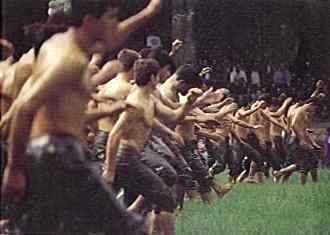 Allah Allah illalah Allah Allah illalah
May we prosper
Our patron is Hamza the wrestler
Our ancestors were wrestlers
Two valiant men take the field
One blond one dark
Both seek the prize
Do not despair when down
Do not boast when uppermost
When above do not let go
Meet leg trip with leg trip
Send a prayer to Muhammed
I hastened to the spring
May God be with both of you.
For 630 years the celebrated Kırkpınar oil wrestling tournament has commenced with
this chant. The master of the festival, known as the cazgir, recites a prayer for
the wrestlers. Then the drums zurna (a wind instrument with a double reed) begin to
play, hundreds of wrestlers bow in salute, and the first pairs lock in combat on the green
meadow.
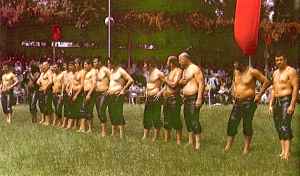 There
are several versions of the story about how the Kırkpınar wrestling tournament began,
the best known relating how Sultan Murad Is general Süleyman Paşa crossed the
Dardanelles with a vanguard of forty warriors on two rafts, and commenced the march
through Thrace. At every halt the men engaged in wrestling bouts as a way of forgetting
the hardships of the journey. One day when they reached a meadow at Ahırköy near Edirne
they began wrestling as usual. As the sun set only two wrestlers remained, neither able to
inflict defeat on the other. They continued to wrestle into the night until finally both
collapsed and died of exhaustion. They were buried where they fell, and the next day a
spring of crystal clear water appeared on the spot. There
are several versions of the story about how the Kırkpınar wrestling tournament began,
the best known relating how Sultan Murad Is general Süleyman Paşa crossed the
Dardanelles with a vanguard of forty warriors on two rafts, and commenced the march
through Thrace. At every halt the men engaged in wrestling bouts as a way of forgetting
the hardships of the journey. One day when they reached a meadow at Ahırköy near Edirne
they began wrestling as usual. As the sun set only two wrestlers remained, neither able to
inflict defeat on the other. They continued to wrestle into the night until finally both
collapsed and died of exhaustion. They were buried where they fell, and the next day a
spring of crystal clear water appeared on the spot.
This meadow was thereafter known as Kırkpınar or the Forty Springs in memory
of the first Turkish warriors to set foot on European soil.
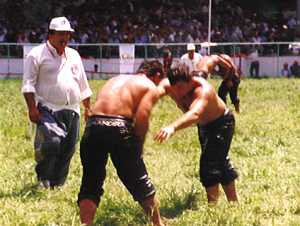 The historian Osman Nuri Peremeci writes in his History
of Edirne that a Wrestlers Lodge was established in Edirne soon afterwards, and that
here the local wrestlers held matches twice a week during the winter. But in summer, they
wrestled outdoors in the flat meadows near the city. The historian Osman Nuri Peremeci writes in his History
of Edirne that a Wrestlers Lodge was established in Edirne soon afterwards, and that
here the local wrestlers held matches twice a week during the winter. But in summer, they
wrestled outdoors in the flat meadows near the city.
During the spring festival of Hıdrellez a three day tournament was held on the meadow
of Kırkpınar, which is situated today near the village of Samona over the frontier in
Greece. Famous wrestlers from all over the Ottoman lands would gather here for the event,
and the Wrestlers Lodge would provide food and accommodation for the contestants. Today
the Kırkpınar Grease Wrestling Tournament is still held annually at Sarayiçi in Edirne.
The 17th century writer Evliya Çelebis
description of the tournament in his Travels begins:
One hundred to one hundred and fifty pairs of wrestlers gird their leather trousers
and fifty pairs of wrestlers gird their leather trousers and grease themselves with yellow
butter. Then legs a straddle like human dragons they grasp one another with the strength
of lions and display their skills to the spectators.
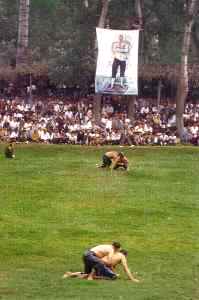 Today, hundreds of wrestlers from all over Turkey who have been
preparing for the tournament over the previous year, pour into Edirne for this festive
event. Just as they have been for centuries, makeshift restaurants, coffe houses, stalls
and funfairs are set up Sarayiçi. Today, hundreds of wrestlers from all over Turkey who have been
preparing for the tournament over the previous year, pour into Edirne for this festive
event. Just as they have been for centuries, makeshift restaurants, coffe houses, stalls
and funfairs are set up Sarayiçi.
The mood at the wrestling field itself is one of intense excitement. Wrestlers wearing
the traditional tight pants made of calf or goats leather grease their bodies not with
the butter of yesteryear, but with olive oil poured in ewers from huge cauldrons.
The event begins with the ceremonial auction of a ram to the highest bidder, who
becomes the master of that years tournament. After the opening prayer, the loud
rhythmic sound of drums and zurnas breaks out and the wrestling commences. The monotonous
music is exhilarating, and the spectators begin to identify with the losers and sharing
the thrill of victory with the winners. The scene takes on a dreamlike unreality, all
other sounds eliminated by the relentless beat of the music. For three days the wrestling
field is never empty. If enthusiasm shows any sign of waning the musicians switch to a
faster rhythm.
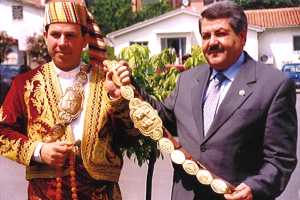 The eleven classes of grease wrestling run from the lowest known as teşvik
(encouragement) up to the highest known as baş güreşler (head wrestling). All
the wrestlers struggling to come first in their class also aspire to become one of the başpehlivan,
or master wrestlers. The eleven classes of grease wrestling run from the lowest known as teşvik
(encouragement) up to the highest known as baş güreşler (head wrestling). All
the wrestlers struggling to come first in their class also aspire to become one of the başpehlivan,
or master wrestlers.
The matches between the başpehlivan take place on the last day, when excitement soars
to a climax as the losers are eliminated, finally leawing the last two contestants alone
on the field to wrestle for the gold belt. The championship fight may last many hours.
The saying goes that a defeated wrestler is never satiated, and as the losers
leave Sarayiçi their parting words are inevitably:
See you at Kırkpınar next year!
- Source:
- By Kâmil Fırat
SKYLIFE 6/95
|